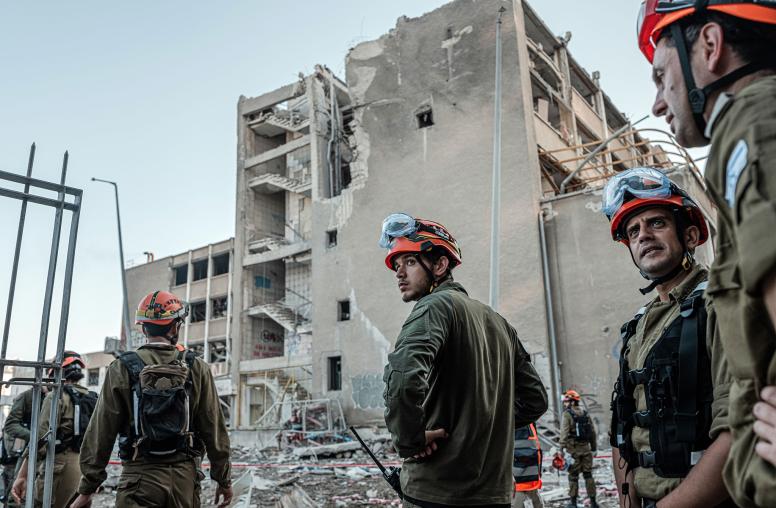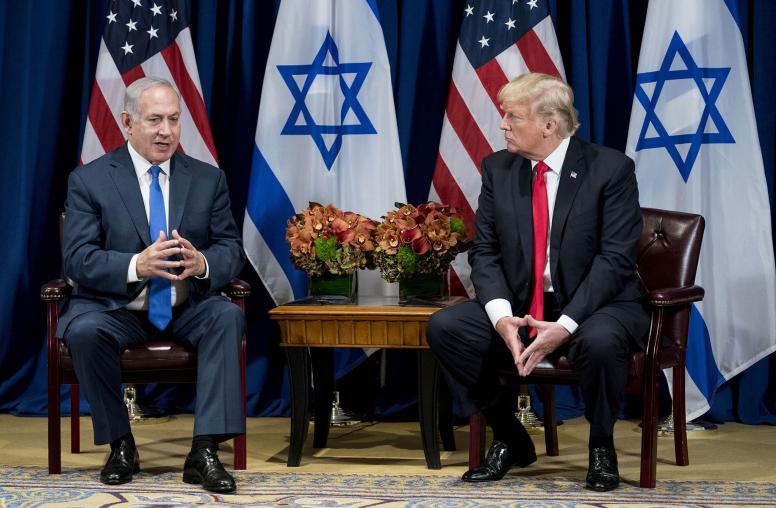The Israeli-Palestinian Conflict: The Danger of ‘No Solution’ Messaging
The Six 'No’s' That Are Cementing a One-State Outcome and Perpetual Conflict.
Israeli Prime Minister Naftali Bennett has made it clear that he has no interest in reviving the Israeli-Palestinian peace process. In a recent interview, he affirmed his longstanding position that he “opposes a Palestinian state and will not allow talks on the line of a Palestinian state.” Echoing Bennett, Israel’s more moderate Alternate Prime Minister Yair Lapid — set to take over in August 2023 — says he, too, will not seek peace talks once he takes office, despite his stated support for a two-state solution.

With the right-wing opposition and the governing coalition in agreement, the message is clear: There will be no negotiations and no two-state solution any time soon, setting Israelis and Palestinians most likely on a disaster-bound trajectory.
Underlying and reinforcing the red lines on talks and two states are “Six No’s” that seem to guide Israel’s current strategy toward the Palestinians.
Israel’s “Six No’s”
The Six No’s are reminiscent of the 1967 meeting of Arab leaders in Khartoum, where they issued a declaration that became known as the “Three No’s”: no recognition of Israel, no negotiations with Israel and no peace with Israel. This position — long-standing but never uniformly adhered to across the Arab World — was dramatically shattered with the 1979 Israel-Egypt peace treaty, followed by the Israel-Jordan treaty of 1994, and then fully reversed by the 2002 Saudi-led Arab Peace Initiative. The initiative implicitly recognized Israel, accepted negotiations as the strategic route for resolving the conflict, and aimed to achieve peace and normal diplomatic relations between all the Arab countries and Israel.
There is perhaps an irony — or a tragedy — to be found in the positional reversal. Whereas Israel evinced flexibility at a historical moment when the Arab states were at their most rigid, today, at a moment when Arab state positions toward Israel are more flexible, Israeli leadership has become more unyielding and offers its own set of “no’s”: no negotiations, no two-state solution, no one-state solution, no freezing of settlements, no Palestinian sovereignty in East Jerusalem and no to the return of any Palestinian refugees to Israel.
No Two-State Solution: Politicians from both the current coalition and the opposition are united in rejecting the creation of a Palestinian state. Prime Minister Bennett, an avid proponent of Israeli settlements who has said “a Palestinian state would mean a terror state,” even found fault with the Trump administration’s peace plan. Despite its overwhelming partiality toward Israel and wide departure from the two-state framework that had garnered international community buy-in, Bennett framed it as a solution aimed at creating two states.
No One-State Outcome: An even greater majority in Israel rejects a shared binational one-state approach since it would undermine the Jewish character of the state of Israel, and thereby the raison d’etre of its creation.
No Negotiations: As noted, both Bennett and Alternate Prime Minister Lapid oppose launching any form of political negotiations with the Palestinians.
No End to Settlements: Although Bennett said that his government will neither annex nor form a Palestinian state, he also said that his government will back settlement construction — a practice that UNSC Resolution 2334 enshrines as “a flagrant violation under international law … [that must] immediately and completely cease.” Given the longstanding premise that a negotiated agreement would be based on a land-for-peace formula, establishing a Palestinian state on territories occupied in 1967, the Israeli government’s continued expropriation of parts of that territory for settlements is chipping away at the possibilities for a viable Palestinian state.
No Palestinian Sovereignty in Jerusalem: Ehud Barak became the first Israeli Prime Minister to show a willingness to divide Jerusalem into two capitals to resolve the conflict. Much ink has been spilled on the reason and responsibilities for the failure of the 2000 Camp David II summit, and on the impact that the brutal violence of the Second Intifada had on both sides.
Causal analysis aside, since the beginning of the 21st century, Israeli leadership has become more adamant in rejecting any division of the city, or even Palestinian claims to a capital therein. Recently, this issue has come to the fore in the Israeli government’s opposition to President Biden’s proposal to reopen the U.S. Consulate in Jerusalem, which served as the de facto mission to the Palestinians before the Trump administration closed it in 2018. Bennett claims that he stood up to Biden on the issue, stating that “Israel has only one capital, Jerusalem, and it is the capital of only one country, Israel.” The Bennett government has also committed itself to expanding settlement building in East Jerusalem, and undermined the long-standing status quo arrangement at the Al-Aqsa Mosque.
No Refugee Return: Finally, over the past 20 years, Israel has taken a harder line in its approach to refugee return. The years 2001-2002 represent the high-water mark on Israeli and Palestinian mutual understandings around refugees. The Clinton Parameters (2001) acknowledged the Palestinian people’s moral and material suffering in the 1948 war; the need for an international mechanism to deal with compensation, resettlement and other issues; and the U.S. role in leading such an effort.
The Clinton Parameters also suggested that Palestinians should have a right to return to the new Palestinian state, to remain where they are, to resettle in a third country, or to be admitted to Israel with a certain limit. The Arab Peace Initiative (2002) called for a just and agreed solution to the refugee problem, in accordance with U.N. Resolution 194 — explicitly recognizing that a solution will not be imposed, and that Israel has a role in negotiating and agreeing to a solution, thus dropping the Arab world’s previous “all or nothing” stance. The Taba peace talks (2001) advanced the Israeli idea of a 15-year, three-track (settlement in Israel, a Palestinian state and a family reunification scheme). Since 2003, Israeli positions have hardened to the point of rejecting any refugee resettlement in Israeli territory. Israel has also heightened its attacks on UNRWA, the U.N. agency serving Palestinian refugees — a clear reflection of its policy and attitude in this regard.
A Volatile Status Quo
The three central leaders of Israel’s coalition government — Bennett, Lapid and Defense Minister Gantz — have all indicated a willingness or desire to “improve the living conditions” of Palestinians. A number of modest steps have been undertaken toward this aim, such as legalizing the status of thousands of Palestinians in the West Bank. However, efforts at “economic peace” have failed numerous times and the conflict’s core issues are not going away. Further, the aim of improving the quality of life for Palestinians is contradicted by Israeli policies including home demolition, evictions and a failure to crack down on increasing incidents of terror against Palestinians by Jewish violent extremists.
Against this backdrop, if the Six No’s implicitly nod to an acceptance of the “status quo,” many in the Israeli right, the prime minister among them, may more explicitly affirm that it is the best or only way forward. Israel’s Interior Minister Ayelet Shaked indicated that “the current situation is the best for everyone.” And as far back as 2013, Bennett told a group of settler leaders that the Palestinian issue will never be resolved and must be endured..
However, the dangers of refusing any flexibility or demonstrating a willingness to offer ideas or alternatives for resolving the conflict or bridging the positions of the parties are many. The U.N. special coordinator for the Middle East peace process told the Security Council recently that “without a realistic prospect of an end to the occupation and the realization of a two-state solution … it is only a matter of time before we face an irreversible, dangerous collapse and widespread instability.” The recurrent wars and violence around Gaza, tensions in East Jerusalem and the West Bank, both with Israeli forces and among Palestinians, signal clearly that the status quo cannot endure.
The Dangers of Rejectionism
Bennett has certainly convinced many Palestinians that the two-state vision is dead. Today, more and more Palestinians, particularly youth, favor pursing their rights within a single state. Palestinian President Mahmoud Abbas warned of this outcome — most forcefully to date — at the U.N. General Assembly. Meanwhile, attitudes are hardening within both societies and outside them. Outside actors, including international human rights organizations such as Amnesty International and Human Rights Watch, are bringing mounting pressure and opprobrium to bear, issuing reports describing the situation on the ground absent progress toward separation into equal Israeli and Palestinian states as meeting the international legal definition of “apartheid.”
Among Israelis and Palestinians, a majority of 15 to 21-year-olds reject the historic claims of the other to the land and mirror each other in believing the other side will only make concessions in response to force, according to a recent USIP and Alliance for Middle East Peace sponsored poll conducted by Drs. Khalil Shikaki and Dahlia Scheindlin (report forthcoming).
This shift in the discourse surrounding the conflict and the trajectory of youth attitudes is significant and signals danger ahead. There are two sides to this conflict, and the Palestinian leadership must also address and be answerable to its own past and present challenges, missteps and faults. Those include a paralyzing political division between the Fatah-led PA in the West Bank and the ideologically opposed and militant Hamas leadership in Gaza; rejectionism and/or passivity; corruption; the clampdown on freedom of expression; and state-building regression. However, as the most powerful actor in the conflict, and the one controlling most of the territory, Israel must wrestle with the immediate and longer-term implications of two peoples sharing one piece of territory, without stated willingness to ultimately separate into two separate bodies, or to ultimately provide equal rights in one state as an alternative.
There are indeed practical reasons why negotiations between Israelis and Palestinians are not imminent and may not succeed today. Yet progress toward preserving the possibility of peace is still possible and necessary, even in these dire times. In the near-term, two objectives are paramount: a return to agreement on the political horizon for resolving the conflict and an agreement that neither party will take steps to undermine the path towards resolving the conflict. The alternative represented by these six long-term no’s, coupled with Palestinian division and dysfunction, are a recipe for despair and perpetual violent conflict. Both Israelis and Palestinians deserve better.



